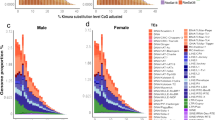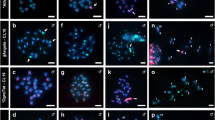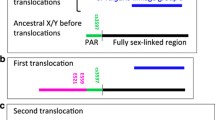Abstract
The study of the molecular structure of young heteromorphic sex chromosomes of plants has shed light on the evolutionary forces that control the differentiation of the X and Y during the earlier stages of their evolution. We have used the model plant Rumex acetosa, a dioecious species with multiple sex chromosomes, 2n = 12 + XX female and 2n = 12 + XY1Y2 male, to analyse the significance of repetitive DNA accumulation during the differentiation of the Y. A bulk segregant analysis (BSA) approach allowed us to identify and isolate random amplified polymorphic DNA (RAPD) markers linked to the sex chromosomes. From a total of 86 RAPD markers in the parents, 6 markers were found to be linked to the Ys and 1 to the X. Two of the Y-linked markers represent two AT-rich satellite DNAs (satDNAs), named RAYSII and RAYSIII, that share about 80% homology, as well as with RAYSI, another satDNA of R. acetosa. Fluorescent in situ hybridisation demonstrated that RAYSII is specific for Y1, whilst RAYSIII is located in different clusters along Y1 and Y2. The two satDNAs were only detected in the genome of the dioecious species with XX/XY1Y2 multiple sex chromosome systems in the subgenus Acetosa, but were absent from other dioecious species with an XX/XY system of the subgenera Acetosa or Acetosella, as well as in gynodioecious or hermaphrodite species of the subgenera Acetosa, Rumex and Platypodium. Phylogenetic analysis with different cloned monomers of RAYSII and RAYSIII from both R. acetosa and R. papillaris indicate that these two satDNAs are completely separated from each other, and from RAYSI, in both species. The three Y-specific satDNAs, however, evolved from an ancestral satDNA with repeating units of 120 bp, through intermediate satDNAs of 360 bp. The data therefore support the idea that Y-chromosome differentiation and heterochromatinisation in the Rumex species having a multiple sex chromosome system have occurred by different amplification events from a common ancestral satDNA. Since dioecious species with multiple XX/XY1Y2 sex chromosome systems of the section Acetosa appear to have evolved from dioecious species with an XX/XY system, the amplification of tandemly repetitive elements in the Ys of the section Acetosa is a recent evolutionary process that has contributed to an increase in the size and differentiation of the already non-recombining Y chromosomes.







Similar content being viewed by others
References
Ainsworth CC, Lu J, Winfield M, Parker JS (1999) Sex determination by X: autosome dosage: Rumex acetosa (sorrel). In: Ainsworth CC (ed) Sex determination in plants. BIOS Scientific Publishers, Oxford, pp 121–136
Cermak T, Kubat Z, Hobza R, Koblizkova A, Widmer A, Macas J, Vyskot B, Kejnovsky E (2008) Survey of repetitive sequences in Silene latifolia with respect to their distribution on sex chromosomes. Chromosome Res (in press)
Charlesworth B (1996) The evolution of chromosomal sex determination and dosage compensation. Curr Biol 6:149–162
Charlesworth D (2004) Plant evolution: modern sex chromosomes. Curr Biol 14:R271–R273
Charlesworth D, Guttman DS (1999) The evolution of dioecy and plant sex chromosome systems. In: Ainsworth CC (ed) Sex determination in plants. BIOS Scientific Publishers, Oxford, pp 25–49
Charlesworth B, Sniegowski P, Stephan W (1994) The evolutionary dynamics of repetitive DNA in eukaryotes. Nature 371:215–220
Clark MS, Parker JS, Ainsworth CC (1993) Repeated DNA and heterochromatin structure in Rumex acetosa. Heredity 70:527–536
Di Stilio VS, Kesseli RV, Mulcahy DL (1998) A pseudoautosomal random amplified polymorphic DNA marker for the sex chromosomes of Silene dioica. Genetics 149:2057–2062
Feliciello I, Picariello O, Chinali G (2005) The first characterisation of the overall variability of repetitive units in a species reveals unexpected features of satellite DNA. Gene 349:153–164
Filatov DA, Charlesworth D (2002) Substitution rates in the X- and Y-linked genes of the plants, Silene latifolia and S. dioica. Mol Biol Evol 19:898–907
Filatov DA, Monéger F, Negrutlu I, Charlesworth D (2000) Low variability in a Y-linked plant gene and its implications for Y-chromosome evolution. Nature 404:388–390
Hobza R, Lengerova M, Svoboda J, Kubekova H, Kejnovsky E, Vyskot B (2006) An accumulation of tandem DNA repeats on the Y chromosome in Silene latifolia during early stages of sex chromosome evolution. Chromosoma 115:376–382
Jamilena M, Mariotti B, Manzano S (2008) Plant sex chromosomes: molecular structure and function. Cytogenet Genome Res 12:255–264
Jiang C, Sink KC (1997) RAPD and SCAR markers linked to the sex expression locus M in asparagus. Euphytica 94:329–333
Jobling MA, Tyler-Smith C (2003) The human Y chromosome: an evolutionary marker comes of age. Nat Rev Genet 4:598–612
Kejnovsky E, Kubat Z, Hobza R, Lengerova M, Sato S, Tabata S, Fukui K, Matsunaga S, Vyskot B (2006) Accumulation of chloroplast DNA sequences on the Y chromosome of Silene latifolia. Genetica 128:167–175
Kejnovsky E, Hobza R, Kubat Z, Widmer A, Marais GAB, Vyskot B (2007) High intrachromosomal similarity of retrotransposon long terminal repeats: evidence for homogenization by gene conversion on plant sex chromosomes? Gene 390:92–97
Khadka DK, Nejidat A, Tal M, Golan-Goldhirsh A (2002) DNA markers for sex: molecular evidence for gender dimorphism in dioecious Mercurialis annua L. Mol Breed 9:251–257
Krzywinski J, Nusskern DR, Kern MK, Besansky NJ (2004) Isolation and characterization of Y chromosome sequences from the African malaria mosquito Anopheles gambiae. Genetics 166:1291–1302
Kubat Z, Hobza R, Vyskot B, Kejnovsky E (2008) Microsatellite accumulation on the Y chromosome in Silene latifolia. Genome 51:350–356
Kumar S, Tamura K, Nei M (2004) MEGA3: integrated software for molecular evolutionary genetics analysis and sequence alignment. Brief Bioinform 5:150–163
Lengerova M, Vyskot B (2001) Sex chromatin and nucleolar analyses in Rumex acetosa L. Protoplasma 217:147–153
Lengerova M, Kejnovsky E, Hobza R, Macas J, Grant SR, Vyskot B (2004) Multicolor FISH mapping of the dioecious model plant, Silene latifolia. Theor Appl Genet 108:1193–1199
Marais GAB, Nicolas M, Bergero R, Chambrier P, Kejnovsky E, Moneger F et al (2008) Evidence for degeneration of the Y chromosome in the dioecious plant Silene latifolia. Curr Biol 18:1–5
Mariotti B, Navajas-Pérez R, Lozano R, Parker JS, de la Herran R, Rejón CR, Rejón MR, Garrido-Ramos M, Jamilena M (2006) Cloning and characterization of dispersed repetitive DNA derived from microdissected sex chromosomes of Rumex acetosa. Genome 49:114–121
Matsunaga S, Kawano S (2001) Sex determination by sex chromosomes in dioecious plants. Plant Biol 3:481–488
Ming R, Wang J, Moore PH, Paterson AH (2007) Sex chromosomes in flowering plants. Am J Bot 94:141–150
Mosiolek M, Pasierbek P, Malarz J, Mos M, Joachimiak AJ (2005) Rumex acetosa Y chromosomes: constitutive or facultative heterochromatin? Folia Histochem Cytobiol 43:161–167
Mulcahy DL, Weeden NF, Kesseli R, Carroll SB (1992) DNA probes for the Y-chromosome of Silene latifolia, a dioecious angiosperm. Sex Plant Reprod 5:86–88
Navajas-Pérez R, de la Herran R, Lopez Gonzalez G, Jamilena M, Lozano R, Ruiz Rejón C, Ruiz Rejón M, Garrido-Ramos MA (2005a) The evolution of reproductive systems and sex-determining mechanisms within Rumex (polygonaceae) inferred from nuclear and chloroplastidial sequence data. Mol Biol Evol 22:1929–1939
Navajas-Pérez R, de la Herran R, Jamilena M, Lozano R, Rejón CR, Rejón MR, Garrido-Ramos MA (2005b) Reduced rates of sequence evolution of Y-linked satellite DNA in Rumex (Polygonaceae). J Mol Evol 60:391–399
Navajas-Pérez R, Schwarzacher T, de la Herran R, Ruiz Rejón C, Ruiz Rejón M, Garrido-Ramos MA (2006) The origin and evolution of the variability in a Y-specific satellite-DNA of Rumex acetosa and its relatives. Gene 368:61–71
Obara M, Matsunaga S, Nakao S, Kawano S (2002) A plant Y chromosome-STS marker encoding a degenerate retrotransposon. Genes Genet Syst 77:393–398
Peil A, Flachowsky H, Schumann E, Weber WE (2003) Sex-linked AFLP markers indicate a pseudoautosomal region in hemp (Cannabis sativa L.). Theor Appl Genet 107:102–109
Rahman MA, Ainsworth CC (2004) AFLP analysis of genome difference between male and females in dioecious plant Rumex acetosa. J Biol Sci 4:160–169
Renner SS, Ricklefs RE (1995) Dioecy and its correlates in the flowering plants. Am J Bot 82:596–606
Ruiz Rejón C, Jamilena M, Garrido Ramos M, Parker JS, Ruiz Rejón M (1994) Cytogenetic and molecular analysis of the multiple sex chromosome system of Rumex acetosa. Heredity 72:209–215
Saitou N, Nei M (1987) The neighbor-joining method: a new method for reconstructing phylogenetic trees. Mol Biol Evol 4:406–425
Sakamoto K, Shimomura K, Komeda Y, Kamada H, Satoh S (1995) A male-associated DNA sequence in a dioecious plant, Cannabis sativa L. Plant Cell Physiol 36:1549–1554
Shibata F, Hizume M, Kuroki Y (1999) Chromosome painting of Y chromosomes and isolation of a Y chromosome-specific repetitive sequence in the dioecious plant Rumex acetosa. Chromosoma 108:266–270
Shibata F, Hizume M, Kuroki Y (2000a) Differentiation and the polymorphic nature of the Y chromosomes revealed by repetitive sequences in the dioecious plant Rumex acetosa. Chromosome Res 8:229–236
Shibata F, Hizume M, Kuroki Y (2000b) Molecular cytogenetic analysis of supernumerary heterochromatic segments in Rumex acetosa. Genome 43:391–397
Shirkot P, Sharma DR, Mohapatra T (2002) Molecular identification of sex in Actinidia deliciosa var. deliciosa by RAPD markers. Sci Hortic 94:33–39
Skaletsky H, Kuroda-Kawaguchl T, Minx PJ, Cordum HS, Hillier L, Brown LG, Repping S, Pyntikova T, All J, Blerl T, Chinwalla A, Delehaunty A, Du H, Fewell G, Fulton L, Fulton R, Graves T, Hou S, Latrielle P, Leonard S, Mardis E, Maupin R, McPherson J, Miner T, Nash W, Nguyen C, Ozersky P, Pepin K, Rock S, Rohlfing T, Scott K, Schultz B, Strong C, Tin-Wollam A, Yang S, Waterston RH, Wilson RK, Rozen S, Page DC (2003) The male-specific region of the human Y chromosome is a mosaic of discrete sequence classes. Nature 423:825–837
Stehlik I, Blattner FR (2004) Sex-specific SCAR markers in the dioecious plant Rumex nivalis (Polygonaceae) and implications for the evolution of sex chromosomes. Theor Appl Genet 108:238–242
Vyskot B, Hobza R (2004) Gender in plants: sex chromosomes are emerging from the fog. Trends Genet 20:432–438
Wilby AS, Parker JS (1988) Recurrent patterns of chromosome variation in a species group. Heredity 61:55–62
Zhang YH, Di Stilio VS, Rehman F, Avery A, Mulcahy D, Kesseli R (1998) Y chromosome specific markers and the evolution of dioecy in the genus Silene. Genome 41:141–147
Acknowledgments
This work was supported by grants BXX2000-1144-C02 and BOS2003-08737-C02 awarded by the Dirección General de Investigación (DGI) of the Ministerio de Ciencia of Spain. The work of BV and EK was supported by the LC06004 grant from Ministry of Education, grant 521/06/0056 from the Grant Agency of the Czech Republic, and grants no. AV0Z50040507 and AV0Z50040702 from the Academy of Sciences of the Czech Republic.
Author information
Authors and Affiliations
Corresponding author
Additional information
Communicated by Y. Van de Peer.
Rights and permissions
About this article
Cite this article
Mariotti, B., Manzano, S., Kejnovský, E. et al. Accumulation of Y-specific satellite DNAs during the evolution of Rumex acetosa sex chromosomes. Mol Genet Genomics 281, 249–259 (2009). https://doi.org/10.1007/s00438-008-0405-7
Received:
Accepted:
Published:
Issue Date:
DOI: https://doi.org/10.1007/s00438-008-0405-7




